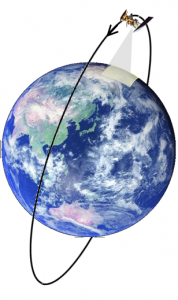
Some satellites are easy to see but you need to know when and where to look. The reason for this is because most satellites are constantly moving around the earth. Most travel from close to the North Pole to close to the South Pole. Because the Earth is spinning, the satellites’ orbit covers the Earth’s surface from top to bottom as well as sideways.
The easiest satellites to see are the biggest ones because they reflect the most sunlight. The best times to see a satellite are around sunrise and sunset. How do yo find the best times to spot a satellite from your own backyard? Fortunately, there are websites that can help you. You can try one on your own. There are also apps that can be loaded on a smartphone. If you do not have a smartphone, ask your parents if they can help you use one.
If you want to look for a satellite using your computer, try this satellite tracker sponsored by Sky & Telescope Magazine.

To use the satellite tracker follow these steps:
- Choose a satellite in the drop down box. Select either the ISS or the Hubble Telescope (HST). (TG-1 was a Chinese space laboratory that is no longer in orbit.)
- Select your country and a city. If your city is not shown, select the one nearest you.
- If it Daylight Savings Time where you live, check the DST box.
- Click on the “Click Here to Display Visibility Predictions for this Location”
The visible passes for the Hubble Telescope are shown in the window:

- The day and time that the satellite can first be seen.
- How long you can see the satellite.
- Which direction the satellite will approach (direction and how high above the horizon.
- Which direction you will lose sight of the satellite (direction and how high above the horizon).
You will notice that all the visible passes will be around sunrise and sunset. That is because the satellite must be able to see the sun but the sky around you must be dark enough for you to see the reflection.
Did you see the ISS or the Hubble Telescope?
Happy Satellite Hunting!
